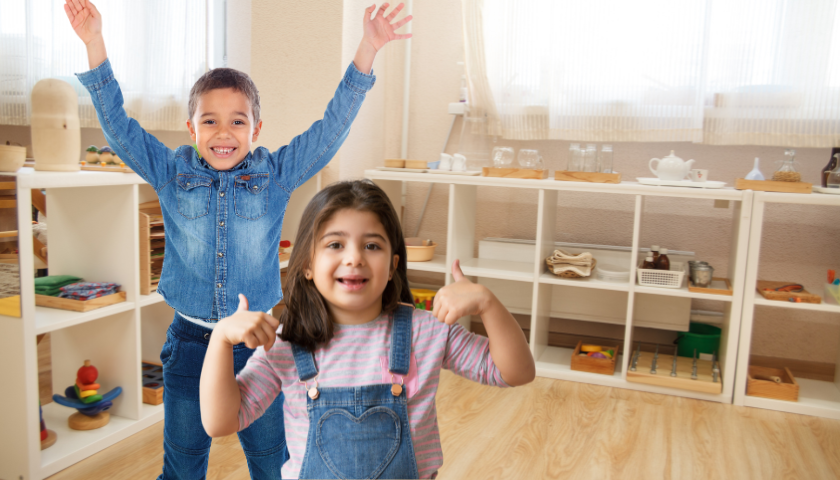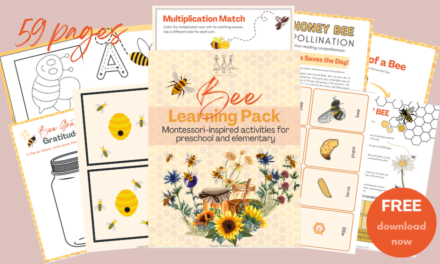Moms love Montessori for good reason. We appreciate the emphasis on child-led learning, independence, and respect for a child’s natural development. A key aspect of the Montessori method is a carefully curated environment that supports children’s exploration and discovery. A well-designed homeschool and play space, infused with Montessori principles, can foster creativity, independence, and a love for learning. In this post, I explore how to use open shelving to create a Montessori-inspired homeschool and playroom.
understanding montessori principles
If you are new to Montessori, you can become more familiar with the core principles of Montessori parenting and the method before diving into the specifics of setting up a Montessori-inspired homeschool and play space by reading my post on 9 Principles Of Montessori Parenting.
how to use open shelves in your child’s playroom or homeschool space
Have you seen beautiful pics of open shelves for kids while scrolling through social media? Why do parents opt for open shelving rather than cabinets or other ways of hiding all the stuff? Open shelving is a fundamental element of a Montessori-inspired environment as it allows children easy access to materials while promoting organization and autonomy. Here’s how to use open shelving effectively in your homeschool or playroom.
1. montessori-inspired homeschool or playroom means easy access to the eye and the hand
Open shelving makes materials easily accessible to your child, promoting independence and self-directed learning. Arrange shelves at child height, ensuring they can reach materials without assistance. This empowers them to select activities based on their interests and preferences. **Important note: All shelving should be secured to the wall to prevent tipping over and injuring a child.**
2. incorporate natural elements
Embrace the use of natural materials in your open shelving display. Wood shelving is beautiful, but if real wood shelving is out of your budget, the inexpensive cube shelving is a perfect substitute. You can use wooden trays or baskets made from natural fibers to add warmth to the environment. Incorporating elements from nature also connects children to the natural world and stimulates their senses.
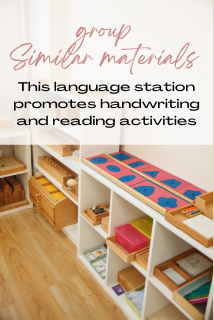
3. displaying montessori materials
Open shelving provides an ideal platform for displaying Montessori materials such as sensorial materials, practical life activities, art supplies, and materials for different subjects. Arrange materials in a visually appealing manner, grouping similar items together. For example, math materials in one section and language materials in another. The same principles apply to your child’s toys and educational games.
4. trays and baskets
Next, use baskets, wood trays, or containers to keep materials that are used together organized and accessible. It makes it easy and intuitive for the child to use and return things to the shelf when they can just pick up a tray with the items for an activity off the shelf, carry it to their work or play area, use it, put all the materials back onto the tray, and return it to its place on the shelf. A little parental guidance is needed for this in the beginning. Once your child becomes accustomed to the routine, it becomes second nature to keep everything in its place.
5. promoting order in the montessori-inspired homeschool
Maintain order on the open shelves by clearly labeling materials and providing designated spaces for each item. Encourage children to return materials to their proper place after use, fostering a sense of responsibility and respect for the environment. Also, model organization and tidiness, demonstrating the importance of caring for shared spaces.
6. rotation of materials (yes, this is magical)
To maintain children’s interest and engagement, rotate materials regularly on the open shelves. Limiting the number of materials available at any given time prevents overwhelm and encourages children to focus on one activity at a time. Consider rotating materials based on seasonal themes, academic concepts, or your child’s current interests. When you observe they are not using something quite as often, put it into storage and replace it with something else. You may find that when it is later taken out for a new rotation, they have renewed interest and enjoyment in it.
more tips on designing a montessori-inspired homeschool or playroom
In addition to utilizing open shelving, consider the overall layout and design of your homeschool and play space to create a cohesive Montessori-inspired environment.
a. define learning areas
Designate specific areas within the space for different types of activities, such as language (reading, writing, grammar), art, sensory play, and practical life skills. Clearly delineate these areas using rugs, furniture, or shelving units, providing structure and organization. A cotton work rug for the child to define their workspace is very effective.
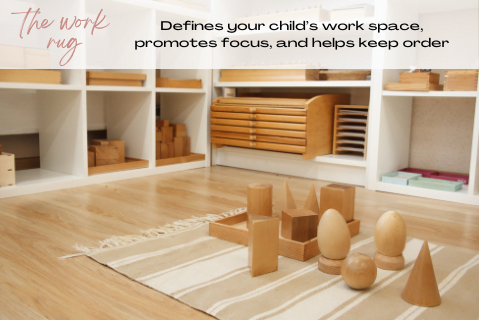
b. incorporate child-sized furniture and tools
Choose furniture that is proportionate to your child’s size, allowing them to comfortably engage in activities independently. Child-sized tables and chairs, low shelves, and floor cushions create inviting spaces where children can work and play comfortably. Child-sized kitchen, cleaning, and construction tools help your child complete tasks with mastery, rather than struggling with implements that are too large for their hands.
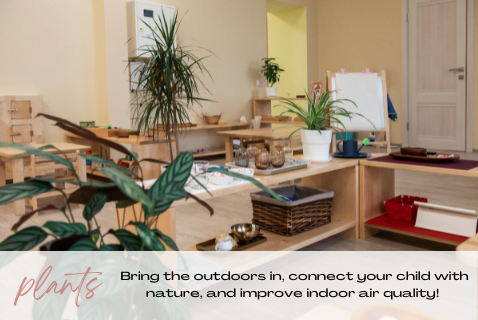
c. create a calm and inviting atmosphere
Pay attention to the overall ambiance of the space, aiming to create a calm and inviting atmosphere conducive to focused learning and exploration. Use soft lighting, natural materials, and neutral colors to promote a sense of tranquility and harmony.
d. personalize the space of your montessori-inspired homeschool or playroom
Finally, involve your child in the design process by allowing them to contribute ideas and preferences for the space. Using plants to decorate is another way you can bring nature into your child’s space. Be sure to incorporate personal touches such as artwork, photographs, and sentimental objects to make the space feel uniquely theirs. Caution, do not OVER decorate. Just like avoiding too many toys or learning materials crowding shelves, avoid crowding walls and surfaces. Physical clutter contributes to mental clutter and stress. A few well-chosen items to personalize will give a just right accent.
Designing a Montessori-inspired homeschool and play space with open shelving is a rewarding endeavor that can foster a child’s independence, creativity, and love of learning. It helps keep your home more organized and your child’s things to be used more often. By embracing Montessori organization, you can provide a nurturing space where your child can thrive academically, socially, and emotionally. Whether you’re homeschooling or simply creating a play area at home, incorporating Montessori-inspired design elements can enrich your child’s educational experience and set the stage for lifelong learning. Enjoy!
We’d love to see pics of your learning or play space. Tag @3momsblognojoke when you share pics of your setup.

Much mom love,
4th of July Beekeeping Breastfeeding Budgeting Childhood Allergies Christmas Culture/Geography/History Doctor Visits Encouragement Food Allergies Free Montessori Printables Free Printables Funschooling Gardening Gluten-Free Grain-Free Home Management Homeschool Curriculum Homeschool for Free Homeschool Organization Homeschool Planning Homeschool Printables homeschool transcript Humor Infant Kids Birthdays Language Arts Meal Planning Montessori Home Montessori Homeschooling Montessori Parenting New to Homeschooling Pets Positive Parenting Practical Life Printable Planners Recipe Recipe Cards Science Summer The Thrifty Widow Toddler Unschooling Vegan Youth sports

